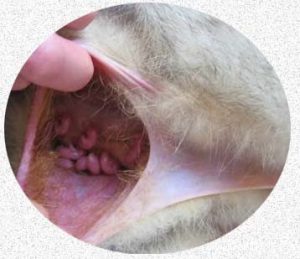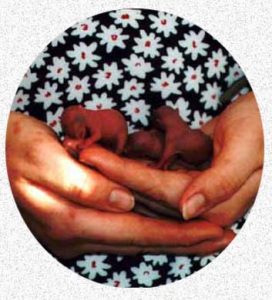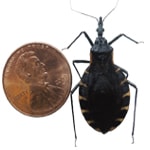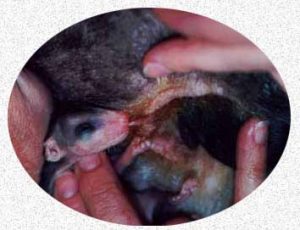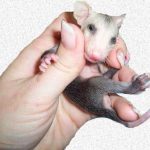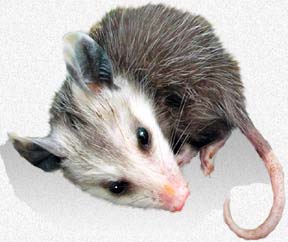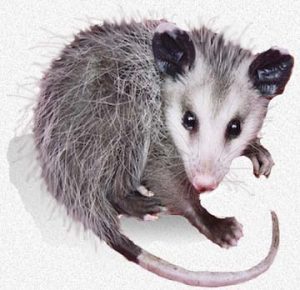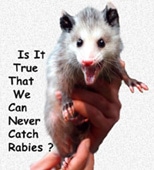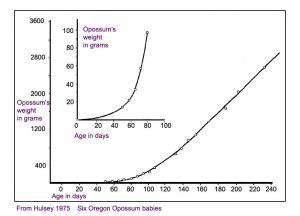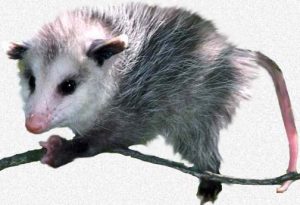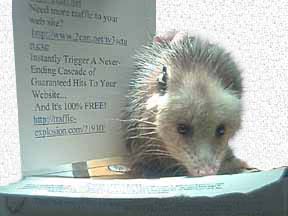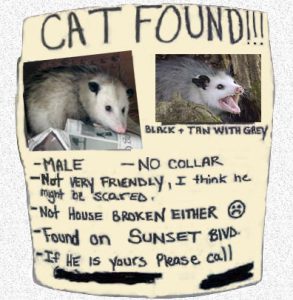Caring for Orphaned Baby Opossums
Ron Hines DVM PhD
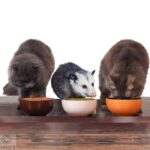 Should I have My Pet Opossum Spayed Or Neutered?
Should I have My Pet Opossum Spayed Or Neutered?
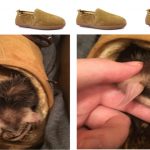 Typhus Is A Disease You Should Be Aware Of
Typhus Is A Disease You Should Be Aware Of
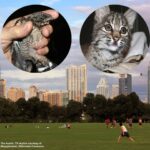
This Is How The Story Usually Begins:
You stop along a roadside where a momma opossum has been killed. When you examine it closely, you find one or more babies still alive on her back or in her pouch !
Or…..You looked in your empty trash can this morning and there’s a little animal in it ! At first you thought it was a rat – but it smiles back at you and you know rats don’t smile.
Or….. your dog’s been yapping all morning at some little creature near the house. What should you do? Welcome to the ancient World of the American opossum – He’s been waddling around it a lot longer than we have.
Can You Tell Me A Bit About This Strange Creature?
The Virginia opossum , Didelphis virginiana, is our only marsupial (pouched) animal. It is also our most ancient furry animal – having remained relatively unchanged for the last 40 million years or so. We associate marsupial animals with Australia – but possums are though to have originated in North America. In fact, the whole marsupial clan may have originated here. Opossums abandoned this continent only to return about 3 million years ago. (ref)
Although opossums that live in the southern and arid areas of the Country tend to be somewhat smaller than their northern brethren, most adult males I see weights about 8-9 lbs and a female 6-7 lbs. Opossums have an exceptionally strong, manipulative tail (but never hang by it like you see in pictures).
Opossums have more teeth (50) than any other American mammal. Those living away from human habitation subsist on insects and grubs, fruit and berries, rodents, carrion and just about anything conceivably edible that comes their way (omnivores). In urban settings, orchard fruit, pet foods left outside and garbage make up a large portion of their diets.
How is Opossum Childbirth Different From What I Might Suppose?
Opossums have a pregnancy that is remarkably short. Their babies are born only 11-13 days after they mate. At such a tender age, these babies are little more than embryos – no bigger than a bumble bee. A baby opossum’s weight at birth is a bit more than one tenth of a gram (0.13grams – the same as 4-5 grains of rice). Fifteen to twenty could fit in a teaspoon. Litter size is generally 7-12. When more are born, the number of available nipples (generally 13) determine how many will survive.
Opossums give birth during all but the coldest months. They are capable of up to three litters per year (although two is the norm). In south Texas and south Florida where I live, October-December is the only time no immature opossums are brought in. By February, most females have infants in their pouches. Soon after their babies are weaned (80 days) the mothers become pregnant again. As you move progressively farther north in America, breeding season and peak baby numbers are delayed by several months. Baby possums remain in the pouch, permanently clamped to their mother’s nipple, for their first 50-60 days. At that time, when they are about the size of a small mouse, they will detach from their nipple and move about. That is also the time when their eyes begin to open and they develop the capacity to chew. Most wean themselves from their mother’s milk by about 82-95 days. They are about the size of a rat by that time. By then the babies can vary quite a bit in size – probably depending on their prior position in the mother’s pouch and the amount of milk that nipple afforded them. These are only estimates: the baby’s time in each stage is quite variable.
Occasionally one finds a mother opossum dead along the roadway with semi-independent babies clinging to her fur or wandering about and very immature ones in her pouch (the result of a second breeding). You can read an early study on the life of Texas possums here.
Does This Baby Opossum Really Need My Help? 
If you found the baby trapped in the waste receptacle or it was cornered by your dog, it is almost certainly old enough to get along on its own (7+” from tip of nose to end of tail). Move it gently with a broom to be sure it has no blood on it or obvious injuries, tip the trash bin on its side or provide one, drape a bath towel or other object loosely over the opening and check it the following morning.
If you do not desire an opossum as a neighbor, remove outdoor pet food, dropped orchard fruit or whatever else may have attracted the animal and suggest you neighbors do the same – possums miraculously appear wherever the find a ready food supply. The average home range of an urban opossum is no more than 15 acres – usually less (rural – up to 50 acres). Young possums begin to wander early in their lives searching for a suitable site, unoccupied by another possum.
This is a photo of an opossum that does not need your help – it is just a teenager looking for a suitable area to set up shop.
What About Taking The Babies To Some Local Wildlife Center?
If the baby is injured that is a good idea. If the baby is 7+ inches long and appears healthy, just cover it in a shady area until nightfall and it will leave on its own. Taking such an opossum to a group facility will just expose it to stress and disease. If the babies eyes have not opened, the folks at these centers will have much more success in raising it than you are likely to have.
But grouping large number of any wildlife in a small area such as a wildlife rehabilitation center is an invitation for stress, and disease transmission between the animals. I prefer when these organizations distribute the orphans among a loosely knit group of talented individuals that care for them in small numbers in their homes. Mixing the public, volunteers, school tours, office functions, educational activities and orphan animals in one location is rarely a good idea.
If the baby is immature, when you call, ask if they have the time to raising the really small ones or just put them down. Not all facilities have the resources or staff to care for all the younger ones. These folks work out of the kindness of their hearts – States do not subsidize them. During the Summertime most are overwhelmed. They never have enough money to do their job as they would like to – do not drop of animals without giving them as generous a donation as you can afford.
What About Calling Animal Control?
I never suggest that. Some municipal shelters kill the animals. Those that do not are often untrained in selecting good release sites, first aid, animal hygiene and the specialized needs and characteristics of native wildlife.
Are There Laws That I Need To Be Aware Of?
Yes
You can trap, shoot and eat or stuff native wildlife – but by law, you cannot personally assist them without being certified by your State to do so. What you do with that information is strictly up to you. (In Texas, all licensed veterinarians are free to treat injured wildlife.)
Are There Any Health Dangers To Me, My Family And My Other Pets If I Interact With This Opossum?
Yes
Dear reader, I have been raising wild, orphaned opossums for 60+ years. I see living life as managing your risks – which ones you choose to accept and which ones you choose to avoid are your decisions alone. So it is up to you to decide what risks you choose. That said, I do not know of anyone who became seriously ill from caring for an orphaned opossum baby.
Opossums will bite if antagonized. Even after they are accustomed to you, they will still bite if startled. Their mouth and teeth contain a number of bacteria that have the potential to cause serious infection. So people with chronic health problems, a weakened immune system, the elderly and very young should never risk being bitten by an opossum. Once bitten by an opossum, prompt first aid and antiseptics are very important. So is scrupulous personal hygiene. If post-bite hygiene and antisepsis did not hurt you considerably more than the bite, you were deficient in tending to the wounds. You can read about some of the bacteria commonly found in the mouths of opossums here.
Wild opossums are not suitable playthings or show-and-tell items for children.
What Are Some Of The Infectious Diseases Humans and Opossums Share?
Opossums are one of the least specialized animals that live in North America. That is, they are highly adaptable in food sources, living locations and lifestyle – more so than any other mammal I know of. That adaptability and their scavenger nature expose them to all types of disease organisms. Many of those organisms have the potential to infect humans as well. When I worked for the NIH, it was thought that opossums might make suitable experimental animals. With that in mind, a survey was made of all known diseases that opossums were susceptible to. However, just the fact that a disease organism could be experimentally grown in an opossum does not mean that opossums posed a significant, real-life threat of transmitting that disease. Keeping that in mind, you can read the results of that study here.
Salmonella
All wildlife are potential carrier of salmonella bacteria. You can read about salmonella bacteria here. If opossums are to be screened for salmonella, the most sensitive tests involve PCR testing of the animal’s stool. When an individual opossum is found to harbor salmonella, there are effective treatments (ref) Most animals that carry salmonella look perfectly normal.
Rabies
Opossums appear quite resistant to catching rabies in a natural setting. Between 1980 and September 2002, 46 people in the United States died of laboratory- confirmed rabies. None were recorded as due to opossum bites. In 2010 there were only 3 reported cases or rabid opossums in the US. In 2009 there were three as well. So although it is conceivable to catch rabies from an opossum bite, it is thought to be highly unlikely.
Click on the image for a letter about that.
Leptospirosis
In a Maryland study of 1970, 15.6% of 955 wild trapped opossums showed evidence of prior exposure to leptospirosis. How many were actually carriers of that disease remained unknown. You can read an article of mine on Leptospirosis when it occurs in dogs here.
Typhus
Murine typhus is a disease transmitted by rat fleas. Urban opossums often carry fleas (although most are cat fleas) and possums have been known to show evidence in their blood of prior typhus exposure. So any fleas on a wild opossum of any age need to be dealt with promptly. It is, however, more likely that you would be exposed to typhus from a cat – in a study in Los Angeles, 90% of the outdoor cats showed evidence of exposure as opposed to only 42% of trapped adult opossums. (ref)
External Parasites
Once opossums have left the pouch, they often carry fleas and ticks. It does not take many fleas to cause a young opossum to become weak and anemic. The best way to handle this problem is by picking the parasites off one-by-one with tweezers (I drop them into a cup of vodka or rubbing alcohol) . Do not rub small opossums down with alcohol-containing products – it chills them. Deal with fleas and ticks before you contaminate towels or bedding with parasites – take a hot shower and put your clothes through a hot dryer cycle when you are finished. Products that are approved for use on kittens can also be used on young opossums. These products should be daubed on with a cotton pledget – not sprayed. They should not be used on the infants head and neck area (fleas that fall off need to be flushed down the toilet as they occasionally come back to life). Urban opossums are much more likely to carry fleas than rural opossums. The opposite is true with ticks. You can read more about the common skin parasites of opossums here.
Internal Parasites
Dear reader, In one study, 3.4% of juvenile opossums were found to be carriers of sarcocystis. (ref) I know of no human cases of sarcocystis in North America. But I need to tell you that opossum feces are thought to be the primary way this parasite moves around. I have never tested an opossum for sarcocystis. I do not know of any wildlife rehabilitator who has. But if it concerns you, through 2014, both Zoologix and Texas A&M Veterinary Diagnostic Laboratories offer a PCR screening test for this parasite.
A possum’s habit of scrounging and poking around in the soil make them susceptible to a very large number of internal parasites. Most of these internal parasites live in their digestive system. You can read a long list of all of them here.
We know next to nothing of when and how these parasites infect and affect opossums. Most are probably obtained once an opossum reaches the age at which it scavenges on its own in the wild. But there are parasites that can be passed through mother’s milk. None of that is known as far as possums are concerned. It is always wise for a sample of opossum stool to be analyzed at a veterinary hospital. If no parasites are seen – great. But that is no guarantee that none are present. If parasites or parasite eggs are seen, many of them will be unknown and unidentifiable to all but a university parasitologist.
The late Dr. Anita Henness, was the most knowledgeable veterinarian regarding opossums. She pioneered the use of levamisole injection in ridding opossums of these parasites. She recommended that all orphan opossums other than smaller infants, receive the medication (but at a lower-than-normal dose in the immature). Unlike its use in other animals, levamisole in opossums appears to be considerably more effective given by injection than orally. Unfortunately, levamisole Hydrochloride has become hard to get and is only intermittently available in veterinary form. But it can still be purchased in dry form from Sigma/Aldrich and other chemical reagent companies. When sold in its racemic form, tetramisole hydrochloride, it has a lesser effect.
One can give prazequantel (Droncit®) if tapeworms or trematodes are suspected; metronidazole or sulfa-type drugs if protozoal diarrhea is suspected. The rapidity with which food moves through an opossum’s intestinal tract (more than twice as fast as a dog (ref) ) might be why other worming medications, effective in dogs and cats, do not seem very effective in opossums. Yet some rehab centers do give opossums pyrantel pamoate and fenbendazole designed for house pets.
How Old Is This Opossum Anyway?
Over the years, many people have developed weight or length charts to determine how old an opossum pouchling is. But because adult opossum size and weight is so variable, and because the weight of individual babies in a litter vary considerably, these charts can only be used as a rough guide in estimating your opossum baby’s age. The older they become, the greater the variation. 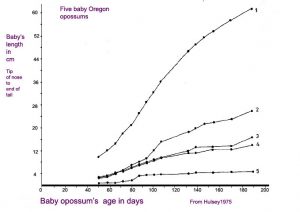
In any case, you will find some of those growth charts if you click on the one above. You will see that recorded infant weights at any given age are quite different in the various reports.
In a small study of opossums in Oregon:
On their first day of birth, baby opossums weighed about 0.13 grams and were about 12.5 mm long.
Hair first appeared on those opossums when they were about 42 days old.
When opossum babies were about 50 days old, they weighed about 14 grams.
At about 58-65 days, their eyes opened.
At about 65-72 days their jaws became motile and they were able to get on and off the nipple.
At about 76 days old they first ventured out of their pouch.
At about 90 days old they normally weaned, but they could be weaned as early as 80 days.
At about 230 days old, those opossums weighed about 2,560 grams (ref)
In another much larger study in Missouri, researches found that opossum babies grow quite steadily in their mother’s pouch for their first 10 weeks. Second and third litters for the year were no smaller or slower in growth than the initial litter. The most common number of baby possums in a litter was 8-10. Early in life, only the front legs show much development. The feet on those front paws have small deciduous (temporary) claws that help the infants make their way to the pouch. In that study, baby opossum’s eyes opened between 50-71 days. The ability to smile means the ability to chew solid food. Opossums developed that ability when they were about 76 days old. You can read that study here.
First week in the pouch: Possum about the size of a garbanzo bean. I have never hand-raise these successfully. Second week in the pouch: By now they have about doubled in size, but their facial features are still indistinguishable and rear legs and tail are only buds. You can distinguish males from females. Third week in the pouch: Rear legs and tail are more recognizable. They are about 3 centimeters long now. Fourth week in the pouch: Babies about 4 cm long now and weigh about 4-5 grams Sixth week in the pouch: Babies have noticeable hair and whiskers.
Tenth week in the pouch: Babies less dependent on their mother’s body heat. their jaws become fully motile so they can get on and off the mother’s nipple. (See if they will lap up formula from a shallow dish.)
Body development is a better gauge of age than weight. Possums at any age before maturity seem heavier when hand raised than weights reported in mother-raised offspring of the same age.
What Are My Chances For Success If I Take On The Job Of Raising This Creature?
When given proper diet and care, opossums that already have some fur on them are quite easy to raise compared to many other orphaned wildlife. Smaller infants are considerably more challenging. Because early infants are born so immature and fragile, they do not give you second chances when you make a mistake.
So do not attempt to raise them without the assistance of a person who has successfully done so in the past. There are sites on the Internet that will inform you who those people are in your area. Some of them will share their knowledge freely and some will not. There will always be more than enough orphan opossums that need a helping hand. Concentrate on rearing the more mature ones successfully before attempting small infants. I suggest that no single person care for more than a few orphan opossums at a time. Group homes and situations where caregivers rotate or where multiple species are reared in the same building are generally less successful. Women tend to have better success rates than men and some people seem to have a natural gift at nurturing and successfully raising one species over another.
What Is The First Thing That Need To Be Done? 
First correct Chilling – Then Fight Dehydration An adult possum’s body temp is about 35.2C (95.36F)
The biggest initial threat to orphan opossums is not starvation. It is lower-than-normal body temperature (hypothermia). Adult opossums have a body temperature lower than all other North American mammals (95.4 degrees F, 35.2 C). (ref)
Infant opossums have more body surface in proportion to their weight, so they chill rapidly. In addition, they do not possess the mechanisms whereby adult possums control their body temperature until they are about ten weeks old (the same time their jaws become fully functional and they can “smile”). When an infant’s body temperature drops below 95F, its heart rate and circulation slows, it turns bluish or a clammy color, it looses the ability to suck and swallow and it looses the ability to absorb nutrients and fluids through its digestive system. Shivering is not a good indication of too low a body temperature in infant opossums.
In the field, wrapping the infant in some soft material and placing it against you body is the safest way to warm it up. Modesty forbids me from telling you exactly where. Once you get home, place it in a small flat-bottomed plastic food container. Small babies should be nestled among portions of t-shirt or underwear material, not towels, because their front claws get tangled in the towel loops. I do not like to use human heating pads. I have seen to many orphaned animals cooked – they are too young to have the ability to withdraw from excessive heat.
The safest initial heat source is a hot water bottle. Long term, rigid washable plastic sealed electric pads sold specifically for pets or livestock have worked best for me. Others build gizmos around 100 watt aquarium heaters. Purchase several aquarium thermometers and place them within the container – not stuck to the outside. Remember that it takes 30-60 minutes before temperatures raised by a heat source top out.
Never give a chilled infant any form of fluid (orally or by injection) until its body temperature has been brought up to normal. By the time baby opossums are dropped off at my animal hospital, they are almost always cold and dehydrated. Despite that, it is amazing how many of these infants are still capable of complete recovery. Most youngsters are found in the morning near mothers killed by the previous night’s traffic, so you are likely to find them in the same condition I did. Initial fluids are best given by injection. That is not something most folks outside of the medical field are experienced at doing. Also, inexperienced people tend to give too much fluid at a single time and to give it too infrequently. So it would be best if a veterinarian, veterinary technician, pediatric nurse or experienced wildlife rehabilitators administered the fluids initially (ringer’s solution, 5% dextrose solution, physiological saline). These fluids are absorbed well by healthy infants when they are given under the skin (subcutaneously). Tuberculin and insulin syringes with the narrowest gauge needles are most appropriate for giving subcutaneous fluids. (never reuse a syringe that once contained insulin). Only experience can tell you how much fluid the infant needs. It depends on the degree to which its skin fails to bounce back when you pinch it, the dryness of the mouth and depression of the eyes. Generally, you can safely give an amount roughly equal to the volume of their heads divided on either side of its flanks like saddlebags. Massage the fluid around gently so it is more rapidly absorbed. Once a typical 500 or 1000ml IV fluid bag has been opened, keep it in the refrigerator between uses. When sterility is in doubt because of multiple withdrawls, it can be re-microwaved (if the bag is removed prior to exploding). Smaller vials of fluid sometimes contain preservatives – I avoid using those. I’ll often add a small amount of B-complex injectable vitamins to these initial fluids as well as injectable ampicillin or cephalexin powder because immature opossums that do not have the benefit of their mother’s milk are susceptible to many bacterial infections.
Minimize Stress
When a wild baby opossum comes to you with its eyes already open, it should be fearful of humans. Keep initial handling to a minimum, keep lighting low, avoid loud noises or sudden movements, keep human activity in the area to a minimum and make hiding places available in the orphan’s enclosure. Cages need to be built securely as these animals will attempt to escape. I prefer plastic tubs with screened lids or a large aquarium over metal-mesh enclosures that tend to injure their noses. Shredded newspaper makes a good substrate, clay and bentonite cat litters do not.
How Should I Care For This Baby?
Buy an accurate digital food scale. The best gauge of your success is a steady increase in body weight and length comparable to the ones found on the charts linked to on this page. What your baby weighs at any given day is much less important than that the shape of the growth curve generally follow the ones on the charts. = Opossums that are less than four inches long from the tip of their nose to the base of their tails need a secondary heat source in or near their enclosure and additional bedding such as wadded paper towels and soft fabrics in their cage. I avoid using bath towels with very smell infants because their toenails get hung up in the loops – use wadded old t-shirts for them instead. Humidity in their environment must not be too low. Rehab centers often obtain discarded hospital pediatric incubators (Airshield™) and find they work well for opossums. Chicken brooders can be adapted for opossums or a setup can utilize commercial pet heating pads like this one. Human heating pads are too unpredictable and get too hot. Heat lamps and light bulbs tend to be fire hazards. Damp sponges in a shallow dish help keep humidity high – babies dehydrate too rapidly in situations of low humidity or high air flow.
What Should I Feed The Baby?
Never feed orphan opossums cow’s milk, goats milk, eggs, honey etc. Just give them Pedialyte until you can come up with a proper formula. If it is peeing, you are keeping it sufficiently hydrated. The best success most of us have had is when we use the powdered form of the PetAg product,Esbilac™ as the basis for opossum diets. Equally good product are the Fox Valley Day One line. (Seasoned wildlife rehabilitator tend to have strong personal preferences for one or the other) The problem with all animal milk replacements sold in powdered form is that they have a tendency to become rancid and not live up to the expiration dates indicated on the container. Refrigerate them all. Buy them in as small a quantity as you can and be sure they have not set on the shelf too long. All are produced by small companies with limited abilities to insure product uniformity from batch to batch or afford frequent in house or contract analysis of the sub-ingredients. There just isn’t a big enough market for these products – that is why Borden’s sold off those production facilities to them years ago. (Don’t be too gruff with them – It is a blessing that these two companies are still out there at all!) I begin by feeding these formulas quite dilute. You are always safer feeding infant diets more dilute, but more frequently, than you are in feeding them more concentrated but less frequently. One part of the powdered formula added to three parts warm water is a good beginning point. Offer it every two hours or so, but never if it is apparent that the previous meal has not been absorbed. I use a 1 cc syringe with a short portion of medical silicone rubber tubing placed over the needle end. (have your local hospital OR save them for you – about #3French size) As the infant grows, the needle can be dispensed with entirely. Others use eyedroppers. Disposable one ml lab pipettes work well for older babies but as they come, they are too hard on the end for smaller ones. The tips of those pipettes can be heated under a cigarette lighter and drawn out into a very fine tube. When an infant will accept a single drop placed in its mouth they are fine, but if the end is to be inserted within the mouth they can be still to stiff without additional soft tubing. The nipples on puppy/kitten nursing bottles are inappropriate for opossums. How you hold the infant (head elevated – no pressure on chest or abdomen and a very slow rate of feeding with frequent breaks) is very important in preventing aspiration pneumonia. Always stop feeding as soon as the infants greediness in accepting the formula decreases even slightly. Do not ‘top them off’ like you do at the gas pump. Increase the formula strength slowly over time until you attain one part powder to two parts water and gradually decrease feeding frequency to every four hours as the amount of formula they consume in a feeding increases. If diarrhea or bloating occurs, cut back on the strength of the formula. Weigh the infant daily and keep a chart. Network on the internet, telephone or in person with other experienced people to discuss potential problems early, but remember that there are as many different opinions as there are wildlife rehabilitators out there. What works for one may not work for another. Never forget that many roads can lead to the same destination. Some wildlife rehabilitators begin to add cereal and applesauce to their orphan’s formula about the time the animal’s eyes open. I have never done that. I believe that those additional ingredients only become desirable at the age that infants would normally consume them – the time they leave the pouch and venture out on their own (about 15 weeks of age). I also do not add vitamins or calcium products to the formula because they should already be there in adequate amounts. (Too much of a good thing is really not a good thing at all.) Some rehabbers associate poor success during the first week on milk formula to toxic residues baby opossums ingested while sucking on a dead mother. That is plausible. I do not know if it is true. The earlier you can wean your opossum baby over to lapping from a shallow dish the better. Most babies can do that by 66 days of age. (ref)
First, that eliminates the possibility of aspiration pneumonia and the digestive problems associated with over-feeding. Second, it allows the animal to develop a wildness it will need after you release it. By the time the baby is 6 inches long, provide it with a shallow bowel of water and, in a second dish, a bit of quality puppy or kitten chow moistened with water. Continue to hand feed until you are certain the infant is maintaining its body weight.
Baby opossum feces are yellowish brown in color with the consistency and form of toothpaste. If it becomes watery and yellow-white you may be giving too much or the baby may have developed enteritis. Then dilute the formula, give it more frequently and you can give very small amounts of kaopectate until the stool is better formed. Greenish bilious stools are also abnormal. At these times, one can crush a little Armour’s Pancreazime over the formula or food to “pre-digest” it.
As soon as one can, introduce the babies to mashed foods: softened puppy/kitten chow, boiled egg, papaya, Gerber’s baby foods, mashed potato, etc. Puppy/kitten chow is quite high in protein as are egg whites, so I don’t let it constitute more than a third or so of their diet. Too high a protein content can have deleterious long-term effects on the kidneys and overall health. (It is not good for body mass and muscle to grow faster than the bones and ligaments that support it.) You can add some NeoCalGlucon to their water or mashed food ingredients for an added supply of calcium or sprinkle crushed calcium lactate tablets to help prevent metabolic bone disease which is a common problem as offspring wean to unbalanced solid diets. I prefer calcium supplements without vitamin D. Some vitamin E antioxidants and omega 3&6 fatty acids dripped over their food might be desirable as well. Be careful not to over-supplement with vitamin D or A. Too much is as bad or worse than too little. By 10-11 weeks of age, babies should be eating on their own. Other good dietary ingredients are diced fruits and vegetables, crickets, minced mice, etc. Avoid cheap or generic cat and dog foods and those that list fish as an ingredient. On can always feed omnivore zoo diets such as Mazuri 5635 too. Under long-term care, opossums need to gnaw at hard kibble and grizzle to keep their teeth clean and their gums healthy. Do not let them become fat.
Be sure they have clean water at all times. They will often use the water dish/bowl as a latrine, so change it frequently.
How Much Formula Should I Give?
You are always safer giving too little than too much – particularly until you know the baby well. It is very difficult to give you exact amounts. It depends on the formula being fed, the way it is fed, the time of day and the individual vigor of the baby. But you can use 0.5cc as an average amount for a ten-gram opossum. By the time it weighs 25 grams, 1.0 cc might be an average amount per feeding. At 50 grams, 1.75-2.75 cc. At 100 grams, 5.0 cc at a feeding. Possum pouchlings are born with a thin membrane (perioral membrane) sealing the sides of their mouths shut except for a tiny nipple-sized opening in the front just large enough to accommodate their mother’s nipple. That membrane releases when the infant is about 60-65 days old – the time it can freely move its jaws and mouth and begin to lap up liquids. (ref)
Stimulating The Baby To Eliminate
Early in their pouch lives, infant opossums need help urinating and defecating. Activity and touch are the best stimulators of elimination. Some use a pledget or cotton or a Q-tip moistened with warm water to gently rub the infant’s genital area. Others find that dipping its front paws in warm water is sufficient to encourage elimination. Once the orphan’s eyes have opened, it should no longer need that stimulation.
Does This Opossum Need Medications Or A Veterinary Exam?
Most do not. If they behave like an opossum, if they have no obvious deformities or injuries and if they will accept food they will probably do well. If you are in doubt, your are more likely to get an accurate wellness report from your local wildlife biologist or professional wildlife rehabiltator than from a dog, cat or livestock veterinarian unless that veterinarian has a personal interest in wildlife or pocket pets. If your local veterinarian will microscopically examine a fecal specimen from the opossum, that is a good idea. It is not that your local vet doesn’t like wildlife as much as you do. Licensed veterinarians can be prohibited by state and federal law from treating protected wildlife presented to them by the public and protection of their staff is another primary concern. No medications are FDA-approved for use in opossums. Determining their correct dosage requires a technique called allometric scaling that few veterinarians are versed in. Veterinarians with specialized knowledge and staff to treat such animals are usually associated with zoos, research and teaching institutions or large wildlife centers. Do not give up on young opossums that are found to have locomotion (mobility) difficulties as the result of accidents and trauma. They have remarkable powers of regeneration. (ref)
You can read articles designed to inform veterinarians about the problems and treatments for common opossum diseases here and here.
What Are Some Of The Health Problems Orphan Possums Commonly Experience?
The most common problem of newly obtained immature opossums is subnormal body temperature, often accompanied by dehydration. The second most common problem is traumatic injuries. The next most common problem are skin parasites, and intestinal parasites. The next most common problem is diarrhea or bloat caused by feeding inappropriate diets or improper feeding techniques. The next most common problem is cannibalism due to too many opossums in a small area, mixing opossums of different size or not separating out the weaker ones. The next most common problem are bone deformities caused by feeding diets too low in calcium and/or vitamin D (metabolic bone disease).
Another commonly seen problem is withering and loss of ear tips, tip of tail and toes. These are the areas most at risk of poor circulation. Some call this “Crispy Ear” others Septic Dermal Necrosis. It has many causes – all related to less than optimal care and diet. Antibiotics and anti-fungal agents, given topically or systemically, can be helpful; but the underlying sub-optimal husbandry needs to be corrected for a cure. When those underlying husbandry problems are fixed, the problem rarely get worse although the prior damage remains evident.
Metabolic Bone Disease
Metabolic bone disease is common in all wildlife kept as pets. It is entirely preventable. The problem is, it creeps up on you. By the time you realize something is wrong, the distortion of the animals skeleton is often extensive. Like a tree that leans a little – with time, it tends to lean a lot. So even after the animal’s diet is corrected, the problem may appear to get worse. When animals are fed diets that do not contain enough calcium or vitamin D or when they are allowed to pick and choose among the dietary ingredients offered to them, their bodies will be slowly drained of calcium. Many well-meaning people are not aware that diets composed primarily of meat are highly deficient in calcium and contain an excess amount of phosphorus as well. When opossums eat prey animals, they eat them bones and all. Pet food companies get around this by supplementing their diets with bone meal or calcium carbonate. Both excessive and deficiencies in vitamin D are also thought to play a role in some cases. When I work with reptiles, there is some though that a diet high in cruciferous vegetables (high in oxalates) contributes to metabolic bone disease. You can read more about that here. (No one knows the effect of oxalates on opossums, but high-oxalate diets are certainly not the common cause of opossum MBD.) Blood levels of the possum’s calcium are preserved as long as possible at the expense of their bones, which become more and more fragile and deformed. Microscopic fractures occur, distorting bone shape and leading to easy fractures and subsequent paralysis. In this way, it is quite similar to the osteoporosis that occurs in older humans. Rickets, osteomalacia and secondary hyperparathyroidism are all forms of metabolic bone disease. These problems can be stopped once the animal is placed on a balanced diet – but they can never be fully corrected. Do not release these animals – a healthy opossum’s life is difficult enough – a handicapped one’s too cruel. Keep those animals as pets, supplement their diets in a secured, fenced-in area or put them down.
What About Exercise?
Inactivity is never healthy. It is hunger and reproduction that drives activity in wildlife , and captive opossums have their food brought to them on a platter and no romance in their lives. You can help by offering older babies environmental enrichment techniques that make food gathering a game. Read more about enrichment here. As babies mature – cages need to be quite large, with stumps, branches and perches – like small monkey zoo exhibits. I have never offered opossums exercise wheels, but some find that they use them. My personal inclination is to just offer them more space, more opportunities to climb and offer food in ways that make them work a bit to satisfy their hunger.
When Should I Let The Opossum Go When The Time Comes?
A good time to release an opossum is when it is 20 weeks old. That should not be done without considerable preparation to increase its chances for survival in the wild. First, the less contact you have with the animal during its last weeks with you, the better. Its natural tendency to fear humans will return. Do not let it become accustomed to dogs. Place its food out for it at sundown so it becomes accustomed to feed at night. Offer it whole prey items – thawed mice, rats, chicks, as well as crickets and mealworms. You can order them deceased over the internet (ref) (I no longer have the heart to kill rodents). Don’t serve the items in a dish, make the possum dig and root around for them. Build an outdoor cage if you can and make it as natural as possible. (unless the enclosure wire bends in 8-12″ inward at the ground, the critter will dig out (ref) If possible, house it with another opossum of similar age.
Begin to think about where you will release it. Suburban settings are as appropriate as rural settings. I know of no studies that indicate that urban opossums live shorter lives than their rural brothers. In cities, roads and dogs will take the lives of many. In rural settings, it will be coyotes, foxes, bobcats, eagles, owls and hunters. That is why an opossum’s average life in the wild is only two years. In most cases, the best place to release an opossum is close to the place where it was found. Moving animals long distances can be an invitation to the spread of disease and any area that can adequately support opossums almost certainly already has all it can support. More opossums, introduced from the outside rarely survive. You can read about that problem here. When supplemental feeders are used to keep opossum numbers abnormally high, disease outbreaks are sure to follow. I wish I could offer you a simple solution – but there are none. That is why I am ambivalent about condemning folks that decide to keep them as pets. Release your opossums in the evening – as far from a road as possible. Check the weather forecast and hold off a while if heavy rain or freezing temperatures are eminent.
How Long Do Opossums Live
Even in captivity, the average opossum lives only about four years; although occasional ones live much longer. In the wild , an opossums life is short – 1-2 years.
Good luck and best wishes to both you and the opossum,
RSH
You are on the Vetspace animal health website
Visiting the products that you see displayed on this website help pay the cost of keeping these articles on the Internet.

